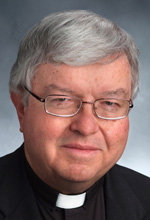Q. I remember being taught, somewhere in my Catholic training, that the Bible never mentions Jesus baptizing anyone, because our sacrament of baptism commemorates the death and resurrection of Christ and he had not yet died and risen. But I recently came across this passage in John’s Gospel (3:22-23): “After this Jesus and his disciples went into the region of Judea, where he spent some time with them baptizing. John was also baptizing in Aenon near Salim.” In Matthew 3:11 though, John says that he is baptizing with water and Jesus will baptize with fire and the Holy Spirit. So my question is this: In John 3:22, isn’t Jesus baptizing with water, or what else would that quote mean? (Milwaukee, Wis.)
A. You raise a good question, and the plain truth is that we don’t really know whether Jesus baptized anyone with water during the two and a half years of his public ministry. The scriptural passage to which you refer (John 3:22) would seem to indicate that Jesus did baptize, along with some of his disciples.
However, if you continue on just a few more verses, you will read (John 4:1-3): “Now when Jesus learned that the Pharisees had heard that Jesus was making and baptizing more disciples than John (although Jesus himself was not baptizing, just his disciples), he left Judea and returned to Galilee.”
The synoptic writers — Matthew, Mark and Luke — offer no clarity on this, because they are silent on the question of Jesus baptizing.
What we know is this — if Christ did in fact baptize during the early days with his apostles, it was not the sacrament of baptism as we know it today. That sacrament, as you correctly point out, inserts us into the mystery of Jesus’ death and resurrection and applies the merits of Christ’s action to ourselves.
We, the baptized, are initiated into the sacramental life of the church and placed on a path to holiness and to heaven.
Q. My parish regularly changes or omits words from the first and second scriptural readings at Sunday Mass. They claim that, under Vatican II, it is permissible to do so under the inclusive language guidelines. Shouldn’t the Scripture readings be read as they are printed in the Lectionary? (Louisville, Ky.)
A. First, and parenthetically, isn’t it funny how the Second Vatican Council gets blamed for (and sometimes credited with) things that were far from its agenda? During the years of Vatican II (1962-1965), I don’t think that the issue of inclusive language was on the radar screen of the council fathers or of the world.
The answer to your question is stated in a balanced and succinct way by the Office for Worship of the Archdiocese of Los Angeles in guidelines offered to lectors: “In recent years sensitivity for inclusive language in the liturgy has been encouraged. It is important to note, however, that the lector is not at liberty to change the approved scriptural and prayer texts for the liturgy. In the preparation of other texts, such as the general intercessions or commentary of any type, language which is inclusive is always used.”
The approved text for the Mass readings is a modified version of the New American Bible with revised Psalms and revised New Testament; this is the text found in all current Lectionaries in the United States.
In publishing that text, the Holy See accepted some suggestions on inclusive language by a committee of U.S. bishops and rejected others: where, for example, the speaker/author intended a mixed audience, “brothers and sisters” is now allowed in place of the earlier “brethren.” What were not changed, though, were references to God or to Christ.
***
Questions may be sent to Father Kenneth Doyle at askfatherdoyle@gmail.com and 40 Hopewell St., Albany, N.Y. 12208.
PREVIOUS: At first Angelus, Pope Francis says God never tires of forgiving
NEXT: Walk the Way of the Cross through Lent, to holy Week and beyond




Yahshua is the true name of the Messiah. And no, He did not baptize in water. He baptized in the name of the Father, Son and the Holy Spirit. Baptized them in the name because there is salvation in the true name of the Savior, not in water.
The lectionary used in England has a passage from Acts 2 as the first reading for the feast of St Matthias in which there is the reference to choosing a replacement for Judas from among those disciples who had been with them ‘from the time Jesus was baptising’ this is altered in pencil in the copy which was in our church to ‘John was baptising’. As in the Jerusalem and NIV bibles. Why is there no corrigendum issued for this odd error?
john 3:22 refers to John baptizing Jesus. And by the way, when the bible mention Jesus name in any word about baptism, its not water. its the baptism of the holy spirit. Not water. The bible is clear. Johns baptism is water baptism not the Holy spirit. Act chapter 1:4,5.